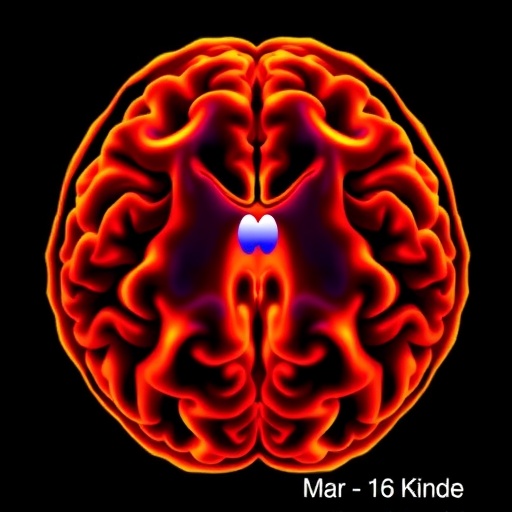Emerging neuroscience research has increasingly highlighted the multifaceted role of the choroid plexus (CP), a small but vital brain structure known for its production of cerebrospinal fluid and contribution to neuroimmune communication. Traditionally viewed as a passive barrier and fluid producer, the CP is now being scrutinized for its involvement in aging-related cognitive changes and psychiatric disorders, particularly bipolar disorder (BD) in the elderly population. A groundbreaking study recently published in BMC Psychiatry sheds light on the association between choroid plexus volume and cognitive function specifically in older-age bipolar disorder (OABD), uncovering neural correlates that may transform our understanding of cognitive decline in this demographic.
The choroid plexus, situated within the brain’s ventricles, constitutes a critical interface between the blood and cerebrospinal fluid, regulating the brain’s immune milieu and metabolic environment. Its role in aging has been hypothesized but has remained elusive until recent advances in neuroimaging allowed precise volumetric analysis. The study utilized a robust sample comprised of 132 individuals diagnosed with OABD and 130 age-matched healthy controls from the expansive UK Biobank database, enabling a comprehensive comparison across multiple brain structural indices.
Using state-of-the-art MRI volumetry, researchers assessed bilateral CP volume alongside measures of gray matter volume (GMV), white matter volume (WMV), cerebrospinal fluid volume (CSV), and total brain volume (TBV). These volumetric parameters were then correlated with composite cognitive function scores derived from standardized testing batteries, aiming to parse out the specific contributions of CP structural alterations to cognitive performance in OABD.
Results were compelling. Patients with OABD were found to have significantly enlarged CP volumes bilaterally, a marker that contrasted starkly against the diminished gray matter and total brain volumes observed in the same cohort. Enlargement of the cerebrospinal fluid spaces was also noted, indicative of overall brain atrophy or ventricular expansion frequently documented in neurodegenerative conditions. This volumetric signature corresponds to a unique neuroanatomical phenotype that might underpin the cognitive challenges faced by these patients.
Intricately tied to these morphological changes was cognitive function: the study found negative correlations specifically between right CP volume and composite cognitive scores, suggesting that larger choroid plexus volume is associated with worse cognitive outcomes. Interestingly, this was especially evident concerning reasoning tasks, further honing in on the neuropsychological domains most sensitive to CP changes. Positive correlations with GMV and TBV hint at a complex interplay where multiple structural factors align to influence cognition.
The researchers delved deeper by applying unsupervised machine learning via k-means clustering to stratify OABD patients into distinct cognitive phenotypes. This approach revealed that those with poorer cognitive profiles exhibited greater bilateral CP enlargement compared to peers with relatively preserved cognition. Such stratification reinforces the concept that CP morphology may serve as a biomarker for cognitive heterogeneity within OABD and possibly predict disease trajectory.
While linear associations between CP volume and cognition were not corrected for multiple comparisons, these findings open an important avenue for therapeutic exploration. The choroid plexus, often overshadowed by cortical or hippocampal studies, emerges here as a compelling target to mitigate cognitive impairment in bipolar disorder, potentially through modulation of neuroinflammation or cerebrospinal fluid dynamics.
Moreover, the observed relationships between cognitive impairment and broader brain structural metrics—gray matter loss and cerebrospinal fluid increases—underscore the multi-dimensional nature of brain aging and mood disorder pathology. They highlight the indispensable need to consider holistic brain changes rather than isolated regions when investigating neuropsychiatric conditions of aging.
These insights align with burgeoning evidence positioning the choroid plexus as a neural sentinel, critically influencing brain homeostasis, immune surveillance, and neurovascular coupling. As patients with bipolar disorder age, the transformation of the CP’s structure may reflect—and perhaps exacerbate—the neurodegenerative and neuroinflammatory processes that contribute to cognitive decline.
Importantly, this study expands our understanding beyond mere volumetric description by linking CP expansion with specific cognitive domains, such as reasoning. It suggests functional consequences of structural abnormalities that could shape individualized interventions. Future research is poised to unravel underlying mechanisms—whether CP enlargement represents a compensatory response or a driver of pathological change.
The potential clinical implications are profound. If CP volume modulation proves feasible, either through pharmacological agents that target blood-CSF barrier permeability or immunomodulatory therapies, it could usher in new frontiers in managing cognitive symptoms in older bipolar patients, for whom treatment options remain limited.
This pioneering work also raises questions about the universality of CP alterations across psychiatric and neurodegenerative diseases. Comparative studies with aging populations suffering from Alzheimer’s or Parkinson’s disease may delineate shared and distinct pathways, fostering broader therapeutic strategies targeting neuroimmune and neurovascular substrates.
In sum, this landmark study in BMC Psychiatry elucidates a critical link between choroid plexus volume and cognitive impairment within the context of older-age bipolar disorder. By highlighting CP emerging prominence alongside conventional brain structural markers, it challenges the neuroscience community to revisit this once-overlooked structure with renewed clinical interest and scientific rigor.
The integration of advanced neuroimaging, machine learning analytic techniques, and comprehensive cognitive assessment in this research presents a blueprint for future investigations, underscoring the necessity to embrace the brain’s complexity as a network of interacting compartments central to mental health and cognitive longevity.
As the population ages and the clinical burden of bipolar disorder’s cognitive symptoms escalates, insights from this study pave the way for innovative diagnostics and therapeutics that could drastically alter patient outcomes, fulfilling a critical unmet need in neuropsychiatric care.
Subject of Research: The role of choroid plexus volume in cognitive function among older adults with bipolar disorder.
Article Title: Association between choroid plexus volume and cognitive function in older-age bipolar disorder.
Article References:
Zhang, L., Qin, K., Li, J. et al. Association between choroid plexus volume and cognitive function in older-age bipolar disorder. BMC Psychiatry 25, 1079 (2025). https://doi.org/10.1186/s12888-025-07506-8
Image Credits: AI Generated
DOI: 10.1186/s12888-025-07506-8 (Published 11 November 2025)




